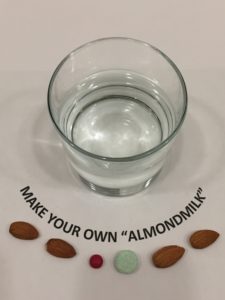Does combining the words “almond” and “milk” into “almondmilk” really alter the meaning in any fashion? Don’t the marketers want us to believe this ersatz product is a dairy substitute made from almonds? And in so believing, should we not expect to use it as we might use actual milk and to receive comparable, though perhaps somewhat different, nutritional benefits? Do you actually know what “almondmilk” is? Let me help.
What Actually Is in “Almondmilk”?
The original Silk Almond (followed by smaller type “almondmilk”) ingredients are “almondmilk” (filtered water and almonds), calcium carbonate (chalk), and a sprinkling of common vitamins. The nutritional analysis shows 30 calories of energy, 1 gm of protein, 1 gm of carbohydrate, and about 450 mg of calcium plus a miscellany of vitamins in each 8 oz cup.
What About Real 2% Milk?
Real cow’s milk (2% fat), not “cowsmilk,” contains about 120 cal of energy, 8 gram protein, 11 gm carbohydrate, 3 gm saturated fat, and 250 mg of naturally occurring calcium. And it’s pretty tasty. The cow doesn’t need additives except for vitamin D. For any growing child and for many adults, milk serves a real dietary purpose and is an excellent source of nutrition.
Ingredients: Mainly 4 Almonds and a Tums
The manufacturer of this product does not describe the exact physical ingredients per 8 oz glass, but we can reverse engineer what it comes from with the aid of the USDA Nutrient Database, which is an easy and reliable source of nutritional information about almost anything you might eat.
Most striking, the protein level in “almondmilk” is only 1 gm per cup, which can only come from the almonds. It so happens that 1 oz of almonds has about 6 grams of protein, and there are about 24 almonds per ounce. So we have about 1/6th of an ounce or 4 almonds per cup to account for the 1 gm of protein.
The 450 mg of calcium in the form of calcium carbonate is about one average size Tums tablet. And the various vitamins shown might be provided by about one third of a standard essential multivitamin pill. (Other versions of Silk Almond “almondmilk” have 60 cal per cup, the additional 30 cal all being from added sugar.) Sounds like a truly natural food, no?
Make Your Own “Almondmilk”
So here’s the recipe for homemade “almondmilk”: Take 4 almonds, soak them in 8 oz water, add most of a standard Tums 500 mg antacid tab, and also a modest fragment of an essential multivitamin, emulsify vigorously in a blender, cool, and drink after again shaking vigorously to resuspend the almond powder. Sound delicious and nutritious? Not so much, at least to me.
The Takeaway
If you happen to like the flavor of “almondmilk” for hydration and possibly for calcium supplementation, feel free. But you shouldn’t have more than two glasses per day or you risk getting too much calcium (which is not desirable), and certainly avoid the sugared varieties. Finally, please don’t give “almondmilk” to children in place of the dairy milk or equivalent that they need for healthy growth and development. The cows win this nutritional face-off.


